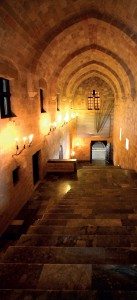Forever young, fascinating and mysterious the old town of Rhodes is a mosaic of heterogeneous cultures, a monument of international historical importance
which transfers visitors to another era, while its fame eternally travels to the ends of the world…
You could say that you can hear the galloping of the horses whispering and the echo of the heavy steps of the armored Knights Hospitallers of St John. And at the same time, a
fascinating Oriental aroma lingers in the air.
Here, historical periods alternate in a fascinating way, creating a mysterious canvas and various tribes and cultures tied their fortunes together in mishmash. This land has
been loved and undoubtedly claimed by foreign conquerors, barbarians or more or less barbarians.
The Medieval Town of Rhodes.
Welcoming, fascinating, mystic and mysterious, full of colors and aromas is an integral part of the island’s history and at the same time its living cell.
Narrow paved streets, dark arcades, gothic towers, byzantine churches, ottoman mosques, squares and houses with blooming yards create the puzzle of the Medieval Town of Rhodes, which is the biggest living Medieval Town in Europe. It is a mixture of different cultures and a mysterious combination of the past with the present, seemingly
hanging between the past of the knights and the modern present times. The Old Town is an exceptional museum of the medieval times and among the top monuments of the
UNESCO World Heritage list.
It is a piece of land that has managed to hold 2.500 years of history on a few acres.
It is a wonderful place where still today, its few thousands of inhabitants and hundreds of thousands of visitors share a beautiful palette of multinational influences.
The Old Town of Rhodes is all this and many more that no writer, no matter how inspired he may be, has been able to put on paper…
A walk through history
The Medieval Town started being formulated in the last quarter of the 7th century BC, on the remains if the previous Hellenistic settlement in the northern part of the island.
Its present im age is due to the presence of the Knights of St. John since 1309 and for the next two centuries.
age is due to the presence of the Knights of St. John since 1309 and for the next two centuries.
A tall defensive wall, which is perfectly preserved, of a length of about 5 kilometers, hosts the Old Town inside it.
It is a very strong wall that resisted even the siege of Mohamed II the Conqueror in 1480, which ended in the defeat of the Turkish army which in fact outnumbered the Greek.
The Old Town was separated with an interior wall into two parts: the Kollakio (Knight’s Quarter) or Chateu, where the nobility and the knights lived and the northern side of
Hora or Burgo, where the Greeks, the Jews and the Franks lived and worked. Hora was developed in the southern part of the Old Town, which was also the biggest.
The landmark of the Medieval Town is the emblematic Palace of the Grand Magister, the renowned Castello in Kollakio, one of the most important monuments of the medieval
times.
The palace dominates the highest spot of the Town and visitors stand in awe before its imposing size.
It was constructed towards the end of the 7th century AD by the Byzantines and originally functioned as a fortress. It was converted into the residence of the Grand Magister and the administrative center of the Knights later, in the beginning
of the 14th century by the Knights of St. John.
Unfortunately it was completely destroyed in 1856 by an explosion of dynamite, which was preserved in the St. John’s church, opposite the Palace, and it was rebuilt in 1939 by the Italian Administrator of the Dodecanese, Mariο de Vecchi.
Today it is open to the public and is also a Museum with numerous exhibits. It is the greatest attractive feature for visitors of the Medieval Town.
The renowned Road of the Knights leads from the port to the Palace. It is the most emblematic, well preserved paved medieval road in Europe and it is 200 meters long and 6 meters wide.
Along the Road of the Knights visitors can see the Inns of the Tongues, in other words the places where knights of the same nationality gathered and also accommodated
their official visitors.
The Knights of St. John in Rhodes were organized into seven different “tongues”: those of France, Germany, Province, Auvergne, Italy, Spain and England, and each “tongue” had its own inn. Four of these seven inns are still intact today.
The shadows of the Knights of St. John can be seen in the semidarkness on the Road of the Knights, with the imposing buildings of the knights, the artistically decorated
entrances with the blazons of the knights and the grand magisters.
The paved Road of the Knights ends on the square of Alexander the Great or of the Museum, where visitors can see the church of Panagia tou Kastrou (Mary of the Castle),
dating back to the 11th century AD. There also stands the Hospital of the Knights, a unique gothic masterpiece, which now hosts the Archaeological Museum of Rhodes,
with a variety of exhibits from the long history of the island.
The walk through the narrow streets of the Old Town continues to the area of Burgo, with the mansions of the Greek and Frank merchants.
In the beginning of Sokratous street, which is the most commercial street of the Medieval Town until today, full of life, on Ippokratous Square, stands the building of Castellania.
It is one of the most beautiful architectural buildings of the knights in Rhodes, with elements of the Renaissance style, built in 1506.
That is where the Commercial Court originally operated similarly to the cities of Western Europe, but today it hosts the Municipal Library and the Historical and Folk Records.
On the other side of Sokratous square, visitors can see the mosque of Suleiman the Magnificent, with its ornate marble entrance, which was built on the position of an older
one that was said to have been erected by Suleiman the Magnificent, who was the conqueror of the town.
At the junction of Sokratous street with Orfeos street stands the Clock Tower, built by Fethi Pasha in 1857 and originally used as an observatory. The view of the Old Town from its top is magnificent.
of the Old Town from its top is magnificent.
Following Archelaou street, visitors get to Arionos square, with the mosque of Mustafa Pasha and the Turkish baths, built on the 16th century and still operating today.
From Ippokratous square begins Aristotelous street, which takes visitors to the east on the square of the Jewish martyrs, with the well known fountain with the hippocampus,
commemorating the Holocaust.
From there, through Pindarou street, visitors get to Panagia ton Aggelon or Burgo (Mary of the Angels), with the three arches of the altar, which is what is left of the wonderful
post gothic temple of the 14th century, after the bombarding during the Second World War, still standing. The sight is breathtaking especially at night with the specially lit arches.
A walk in the Old Town of Rhodes is never enough. Trying it only once is not enough for visitors to see and admire everything that is worth seeing. It is only enough to give
visitors a “taste” of this unique Medieval Town’s aroma.




